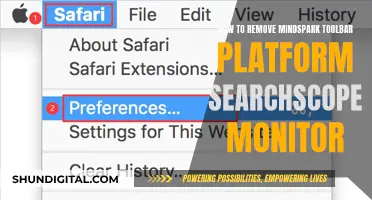
Monitoring your electricity usage at home is important to understand how much energy your household is consuming and to identify areas where energy is being wasted. This can help you make small changes to reduce electricity usage and lower your monthly bills. There are several ways to monitor electricity usage at home, from studying your electricity bill to using smart plugs, smart meters, and energy monitoring devices and apps. These tools provide real-time data on your energy consumption, helping you make informed decisions to optimize your energy usage and reduce costs.
| Characteristics | Values |
|---|---|
| Purpose | To monitor electricity usage in the home to identify areas where energy is being wasted and make changes to reduce electricity use and lower bills |
| Benefits | Knowledge and control over energy usage; ability to identify electricity wastage; accurate data in real-time; reduced household carbon footprint |
| Units | kW (kilowatt) and kWh (kilowatt-hour) |
| Ways to Monitor | Studying bills; energy monitors (small devices or <co: 1,2,3,5>apps); energy monitoring devices; energy monitoring apps; smart meters; prepayment meters |
| Data Collection | Gather monitoring data from bills, prepayment meters, apps, etc.; compare current and past usage; check other time periods; compare different times of day; look for trends |
| Appliance Monitoring | Switch off non-essential appliances; check current usage; switch on appliances one by one to see impact on energy usage and cost; calculate cost of running appliances |
| Saving Electricity | Change the way energy-guzzling appliances are used; update old appliances with energy-saving appliances |
What You'll Learn

Smart plugs for individual appliances
Smart plugs are a great way to monitor the electricity usage of individual appliances. They are small devices that fit between the power socket in your wall and the appliance you want to monitor. They are similar in appearance to power adapters.
Smart plugs are called 'smart' because they allow you to control the appliance they are plugged into remotely, enabling them to function in more environmentally efficient and useful ways. They are widely compatible with all the major smart-home platforms and can be controlled by an app or through a smart home hub, like Amazon Alexa, Google Home, or Apple Homekit. This means you can remotely control the power going into your connected appliances and set up automated actions.
There are many smart plugs on the market, and they vary in features and price. Some of the most popular smart plugs include:
- TP-Link Kasa Smart Wi-Fi Plug Slim (EP25)
- TP-Link Tapo TP25 Outdoor Plug
- TP-Link Kasa Smart Wi-Fi Power Strip (HS300)
- TP-Link Kasa Smart Wi-Fi Plug Mini (EP10)
- BN-Link – BNC-60
- Fayleeko Stand-Alone Plug-in Monitor
- Emporia – Vue Home Energy Monitor
When choosing a smart plug, consider the following:
- Size: Choose a slim model that doesn't block the second outlet or stick out too far.
- Features: Look for features such as energy monitoring, sunrise/sunset scheduling, and Away Mode.
- Compatibility: Ensure the smart plug is compatible with your smart-home platform and devices.
- Ease of use: Opt for a smart plug with a user-friendly app that is easy to set up and navigate.
- Price: Compare prices and features to find the best value for your needs.
Monitoring Data Usage: DD-WRT for Device Control
You may want to see also

Whole-home electricity monitoring tools
Sense Energy Monitor
One of the earliest energy monitors available, the Sense Energy Monitor uses machine learning to identify individual appliances and their electricity usage. It typically identifies a handful of devices in its first month and 20 to 30 in its first year. The base model tracks usage trends in real time by day, week, month, and utility billing cycle so you can figure out your patterns and make adjustments. You can also set energy goals by device or whole home, by day, or in dollars or watts. Over time, the device learns your home's appliances based on their on/off cycles. The Sense Energy Monitor retails for $299.
Generac PWRview W2 Monitor
The Generac PWRview W2 monitor is based on the earlier Neurio W1 and also uses machine learning to identify devices. It costs less than the Sense monitor. The Generac PWRview W2 uses machine learning to identify individual devices and appliances by their unique electrical signatures. It is part of a suite of energy devices made by Generac, including solar panels and storage batteries, and may offer more advantages if you already use their products. The Generac PWRview W2 is priced at around $200.
Emporia Gen 2 Vue Monitor
Unlike the Sense and Generac monitors, the Emporia Gen 2 Vue does not employ machine learning. The basic system measures your overall energy consumption, and you can add sensor bundles to monitor up to 16 individual circuits to keep an eye on specific appliances. The Emporia app can be set to alert you when you are using peak energy or when things like sump pumps don't turn off or on. The Emporia Gen 2 Vue monitor costs less than half of the Generac PWRview W2 and a third of the Sense monitor.
Leviton LWHEM-2R Whole Home Energy Monitor
The Leviton LWHEM-2R Whole Home Energy Monitor allows you to view whole-home energy usage through the My Leviton app. It comes with one pair of CTs and is designed to make your Leviton Load Center smart. It retails for $331.15.
Eyedro Home Electricity Monitor
The Eyedro Home Electricity Monitor provides real-time energy data and history and is available in Ethernet or WiFi Connect (2.4 GHz) versions. It also offers cheaper home versions, as low as $99, depending on your monitoring needs.
TED Pro, Sense Energy, and Eyedro
These are other brands of whole-house electricity-monitoring tools that usually sell for $299 to $349. They work via sensors placed on the lines (usually at the household junction box); the sensors talk wirelessly to meters and gather lots of data, usually uploading it to the web for access.
Monitoring Resource Usage: Strategies for Optimal Performance
You may want to see also

Energy monitors with appliance recognition
While some energy monitors have this feature, the technology doesn't always work perfectly. It's usually easy for the monitor to detect differences between a TV and a refrigerator, but devices that use electricity similarly (e.g. a toaster and a curling iron) may be more challenging to differentiate.
- Sense Energy Monitor: One of the earliest energy monitors available, Sense uses machine learning to identify individual appliances and their electricity usage. It offers whole-house energy monitoring for regular, smart, or solar-powered homes. While it can take time for the monitor to recognize devices, it will eventually let you know which devices are running for more efficient and informed use.
- Smappee Energy Monitor: Smappee's system identifies the unique electric signal of your appliances and allows you to name them for future monitoring. With real-time data, appliance recognition, and mobile app integration, Smappee makes understanding your home energy consumption and savings straightforward.
- Home Energy Monitoring System by CURB: CURB's system provides a suite of tools to monitor and control your energy use in real time. It is compatible with other smart home devices and is solar-ready.
- Engage Platform: The Engage platform is solar-ready and provides real-time energy monitoring on an app and a desktop. The app includes a budget feature to help you set targets and track your use.
- Wiser Energy by Schneider Electric: The Wiser Energy system installs in your home's electrical panel and provides real-time energy usage data, along with notifications when devices turn on or off. The app allows you to track energy savings, set energy goals, and receive recommendations to reduce waste and save money.
Monitoring KWH Usage: A Simple Guide to Energy Tracking
You may want to see also

Detecting vampire loads
To detect vampire loads, you will need a watt-meter or a plug load monitor, such as the P3 Kill A Watt EZ. Here are the steps to follow:
- Unplug the appliance (TV, stereo, DVD player, etc.) that you want to test.
- Plug the appliance into the watt-meter or plug load monitor.
- Plug the watt-meter or plug load monitor into the wall.
- If the watt-meter or monitor displays any energy use, you have detected a vampire load.
- Repeat this process for all the appliances in your home.
- For appliances with vampire loads, consider leaving them unplugged until they need to be used, or plug them into a power strip or smart strip that can be turned off when the appliance is not in use.
By detecting and reducing vampire loads, you can save a significant amount of money on your monthly utility bills and help reduce your environmental impact.
CPU Performance Monitoring: Configuring for Optimum Usage
You may want to see also

Energy monitors with mobile apps
Green Outlet
The Green Outlet app tracks the energy usage of your appliances and devices, helping you calculate your monthly power costs. It also alerts you if you exceed the recommended carbon usage based on government regulations.
Nest Mobile
The Nest Mobile app works with a Nest thermostat, allowing you to monitor and control your energy consumption remotely. It displays a history of your energy usage and provides insights into your devices' energy efficiency.
Meter Plug
Meter Plug is a device that sits between the electrical outlet and your appliance. It transmits data about the appliance's energy usage to a mobile app, helping you calculate the cost of energy usage depending on the time of day.
Meter Readings
The Meter Readings app provides a comprehensive record of your home's utility meters, such as electricity, gas, and solar. It can track up to nine individual meters and displays daily energy usage data, along with costs per day, in easy-to-understand graphs.
Energy Cost Calculator
The Energy Cost Calculator app helps you track the average cost of your appliances by inputting data about their energy consumption. It also allows you to monitor the amount of CO2 produced by your energy use.
Sense Home Energy Monitor
The Sense app uses a small device installed in your home's electrical panel to provide real-time data on the energy usage of every appliance, light, and device in your house. It has a 4.5 rating on iOS and a 4.3 rating on Android.
JouleBug
JouleBug is an app that turns energy saving into a game, encouraging sustainable habits. It provides sustainability tips and allows you to track your progress and impact. It has a 4.5 rating on iOS and a 4.0 rating on Android.
Neurio Sensor
The Neurio Sensor app, coupled with a device installed in your home's electrical panel, monitors and measures the energy usage of individual devices. It is particularly useful for those with rooftop solar installations and is aimed at professionals and householders alike.
Colleges Monitoring Student Online Activity: Is Privacy Invasive?
You may want to see also
Frequently asked questions
Monitoring your electricity usage can help you identify areas where energy is being wasted, allowing you to make small changes to reduce your electricity use and lower your bills. It can also help you to identify appliances that are pushing up your energy bills so that you can cut costs.
There are several ways to monitor electricity usage, including:
- Studying your electricity bill to see what you can learn about your energy usage and costs.
- Using energy monitors, which are small devices or apps that measure and provide real-time data on how much energy you're using.
- Using energy monitoring devices that attach to your monitor and come with handheld screens that display data in real time.
- Using energy monitoring apps that provide the same real-time data as energy monitoring devices, but on your phone.
- Installing smart meters, which are replacements for traditional electricity meters and provide an in-home display of electricity usage.
To monitor electricity usage for specific appliances, you can follow these steps:
- Switch off all lights and appliances except for essential ones that you never turn off, such as your fridge and freezer.
- Check your current usage using an energy monitoring app or device.
- Switch on one appliance, such as your kettle, and use the app or device to see the impact on energy usage and cost.
- Repeat this process for other appliances, such as your oven, microwave, or dishwasher.
- Examine the results to identify which appliances contribute the most to your electricity consumption, and take steps to reduce usage or costs.







